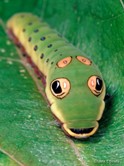
Heather N. Kolich, ANR Agent, UGA Extension Forsyth County
By now, most of us have heard about pollinator decline and may even be participating in conservation efforts. Monarch butterfly conservation is a hot topic, and I’ve given several programs in schools and communities about pollinator protection.
Concern for monarch butterflies arose in the 1990s when observers reported dramatic reductions in monarch populations overwintering in Mexico and California. The loss of milkweed plants (Asclepias sp.) along migratory routes between Canada and Mexico is considered a primary factor.
Unlike bees, who construct or commandeer a nest and provision it with pollen to nourish larvae, butterflies lay their eggs on plants. And not just any plant will do. Each butterfly species seeks out particular plant species to host her eggs and larvae because that plant provides specific nutrient needs for that type of caterpillar. Between hatching and pupating, monarch caterpillars exclusively eat milkweed leaves. To help restore monarch habitats, conservation organizations urge people across the nation to plant milkweed.
Unfortunately, monarchs are not alone in the crisis of habitat loss. Other butterflies are losing the host plants that nourish their larvae. Zebra swallowtail caterpillars feed on the leaves of pawpaw trees, a native fruit plant that gets cleared out by urbanization and is rarely replanted in landscapes. Spicebush swallowtail caterpillars feed on leaves of spicebush, red bay trees, and sassafras trees. Red bay trees are dying throughout the southeast because of laurel wilt, a fungal disease introduced into them from an invasive ambrosia beetle that is native to Japan and India.

While the principle of providing flowers and host plants to sustain migratory monarchs is sound, social fixation on a single plant, like milkweed, may ultimately jeopardize the dynamic biodiversity of local ecosystems. If we widen our viewing lens and plant selection,
however, we can help protect the 1,200-plus native and resident pollinators in Georgia, including 725 species of butterflies and over 540 native bee species.
As home- and land-owners, we can support pollinators by designing our landscapes with a variety of flowering trees, shrubs, and herbaceous plants that bloom sequentially from early spring until the first fall frost. Native plants in their natural forms provide the best nourishment and habitat for pollinators. Native plants and pollinators did, after all, develop over countless generations to support each other. On the other hand, exotic plants and some native plants that have been cultivated for traits like double blooms often lack the nectar and pollen that reward bees and butterflies for their pollination services.
The UGA publication Selecting trees and shrubs as a resource for pollinators provides photographs and descriptions of pollinator-friendly plants for your landscape, and the Georgia-Piedmont Chapter of the North America Butterfly Association offers a quick guide to common Georgia butterflies and their host plants. You can also see several native fruit and nut plants up close and in person at the Forsyth County Sustainable Orchard, located in Chattahoochee Pointe Park. In addition to providing food for people and pollinators, these flowering trees and shrubs make hardy, attractive landscape plants. The orchard is open to everyone for learning and tasting.